
Birds with Long Necks
Have You Ever Stood By A Lake Or Wetland And Found Yourself Fascinated By The Graceful Birds With Long Necks? Their Tall Slender Frames Make Them Stand Out Immediately From Other Birds Almost As If They Were Built To Be Seen Watching Them Glide Across The Water Or Stretch Above The Reeds Can Feel Calming Yet It Also Sparks Curiosity. Why Are Their Necks So Long? What Purpose Does It Serve In Their Daily Lives? These Questions Often Come To Mind For Bird Lovers And Casual Observers Alike, And That Curiosity Is Likely What Brought You Here.
In This Blog We’ll Take A Closer Look At The Incredible Variety Of Birds With Long Necks Found Around The World. From Elegant Swans And Flamingos To Powerful Herons And Cranes Each Species Has Its Own Adaptations And Role In Nature. You’ll Discover How Their Long Necks Help Them Feed Survive And Thrive In Wetlands Lakes And Open Fields. Along The Way, We’ll Share Interesting Facts And Tips To Help You Identify These Remarkable Creatures. By The End You’ll See Birds With Long Necks Not Just As Beautiful But As A Fascinating Example Of Evolution’s Creativity.
American Flamingo

American Flamingo with bright pink plumage and long legs standing in shallow water
The American Flamingo Is Perhaps The Most Iconic Of All Long necked Birds Instantly Recognized By Its Bright Pink Feathers And Tall Stature Native To The Caribbean South America And Parts Of Florida It Thrives In Shallow Lagoons Salt Flats And Lakes Its Long Neck And Uniquely Shaped Bill Are Designed To Filter-feed On Tiny Crustaceans And Algae Which Also Give Flamingos Their Famous Pink Color.
When Gathered In Large Flocks, Flamingos Put On A Show Unlike Any Other. Hundreds Stand Together Stretching Their Necks In Perfect Rhythm While Wading Gracefully Through Water. This Creates A Living Sea Of Pink That Fascinates Birdwatchers Worldwide. Among Birds With Long Necks Flamingos Are Celebrated Not Just For Their Appearance But Also For Their Social Behaviors And Graceful Movements.
| Fact | Details |
|---|---|
| Size | Up To 5 Feet Tall |
| Habitat | Shallow Lagoons Salt Flats Lakes |
| Diet | Crustaceans & Algae (Pink Color Source) |
| Behavior | Highly Social Synchronized Flocks |
| Fun Fact | Their Group Displays Look Like A Pink Sea In Motion |
Black Swan
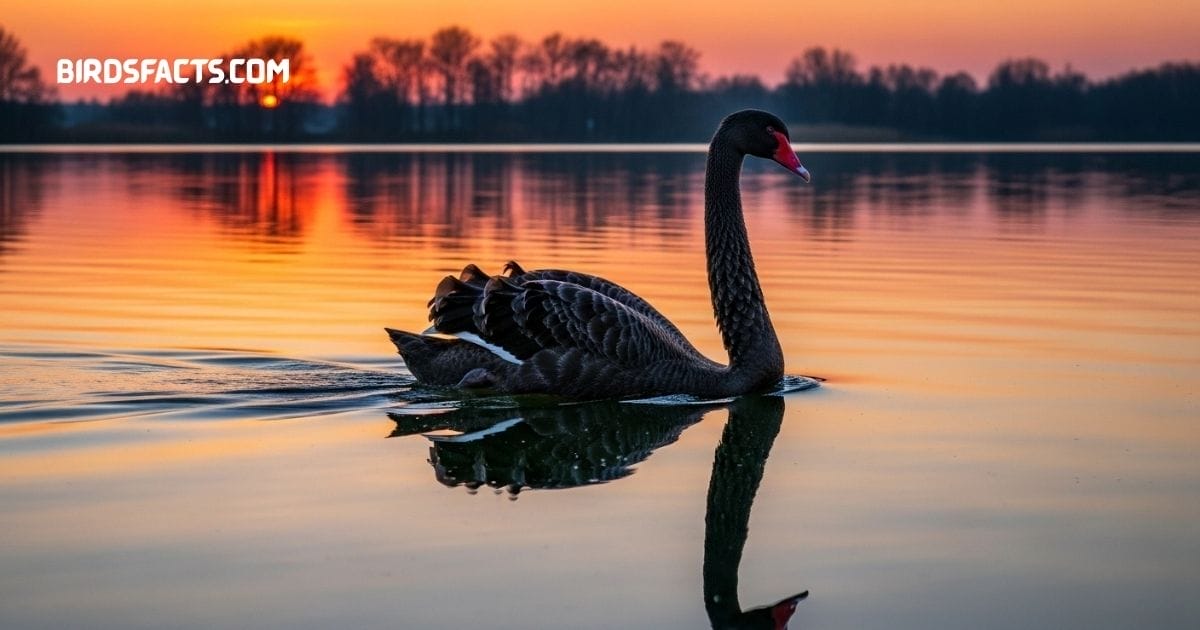
Black Swan with dark plumage and bright red bill swimming on a lake
The Black Swan Is One Of Australia’s Most Elegant Birds With Long Necks Known For Its Deep Black Feathers And Bright Red Bill Its Gracefully Curved Neck Helps It Reach Underwater Plants In Lakes Rivers And Wetlands Unlike The Familiar White Swans Of Europe The Black Swan Stands Out As A Rare And Mysterious Beauty A True Emblem Of Elegance And Calm In The Wild.
During Courtship Pairs Perform Synchronized Displays Arching Their Long Necks Together Sometimes Forming Perfect Heart Shapes On The Water’s Surface. This Beautiful Ritual Has Made Them A Favorite Among Birdwatchers And Nature Photographers Alike. Among All Birds With Long Necks The Black Swan Is Celebrated For Its Striking Contrast Serene Presence And Timeless Symbol Of Grace Found Across Australia’s Waterways.
| Fact | Details |
|---|---|
| Size | 4–5 Feet Long |
| Habitat | Lakes Rivers Wetlands (Australia) |
| Diet | Aquatic Plants |
| Behavior | Courtship Includes Synchronized Neck Displays |
| Fun Fact | Neck Curves Form A Heart Shape In Pairs |
Black-headed Heron
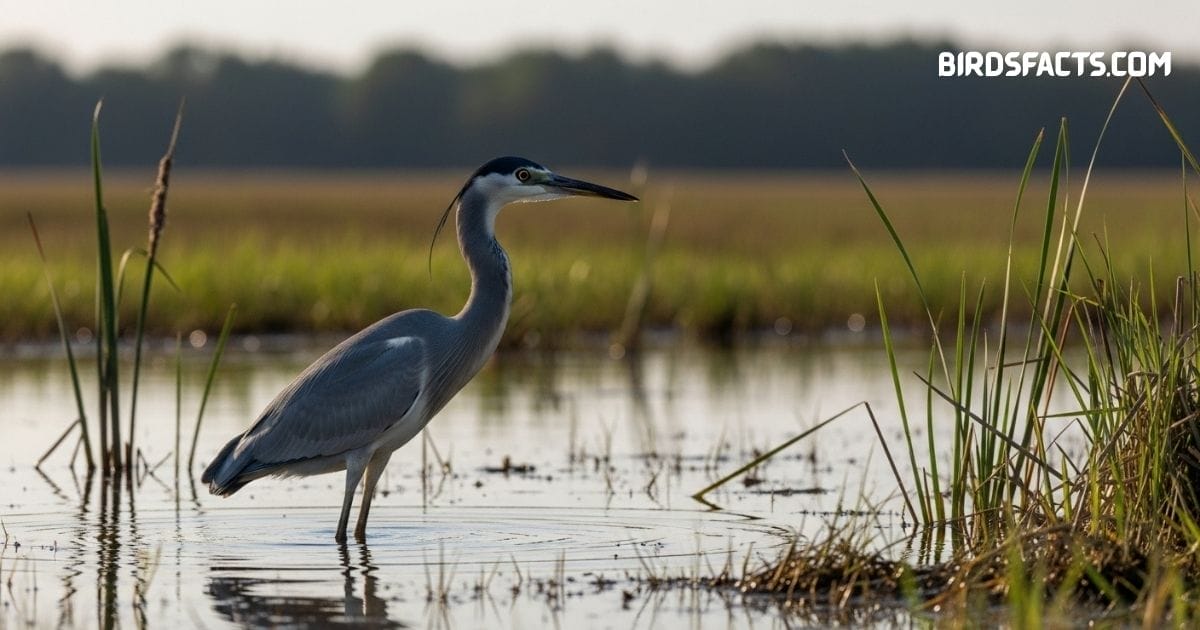
Black-headed Heron with gray body and dark head standing in grassland
The Black-headed Heron Is One Of Africa’s Most Striking Birds With Long Necks Found Across Savannas Marshes And Wetlands With Its Tall Frame And Long S Shaped Neck It Hunts Patiently In Shallow Water standing Still For Minutes Before Striking With Lightning Speed. Its Flexible Neck Bones And Sharp Spear Like Bill Make It Highly Skilled At Catching Fish Frogs And Insects Birdwatchers Are Often Captivated By Its Quiet Focus And Precise Movements.
What Makes This Bird With A Long Neck Remarkable Is Its Perfect Blend Of Patience And Power Its Neck Acts Like A Coiled Spring Releasing A Sudden Burst Of Energy When Prey Draws Near Each Strike Is Swift And Accurate Showing The Heron’s Mastery Of Timing And Control. In The Wild It Remains One Of The Most Fascinating Examples Of Elegance And Strength Working In Perfect Balance.
| Fact | Details |
|---|---|
| Size | Around 3 Feet Tall |
| Habitat | African Savannas Wetlands |
| Diet | Fish Frogs Insects |
| Hunting Style | Silent Stalking & Sudden Neck Strikes |
| Fun Fact | Its Neck Works Like A Spring For Attacks |
Black-Necked Stork
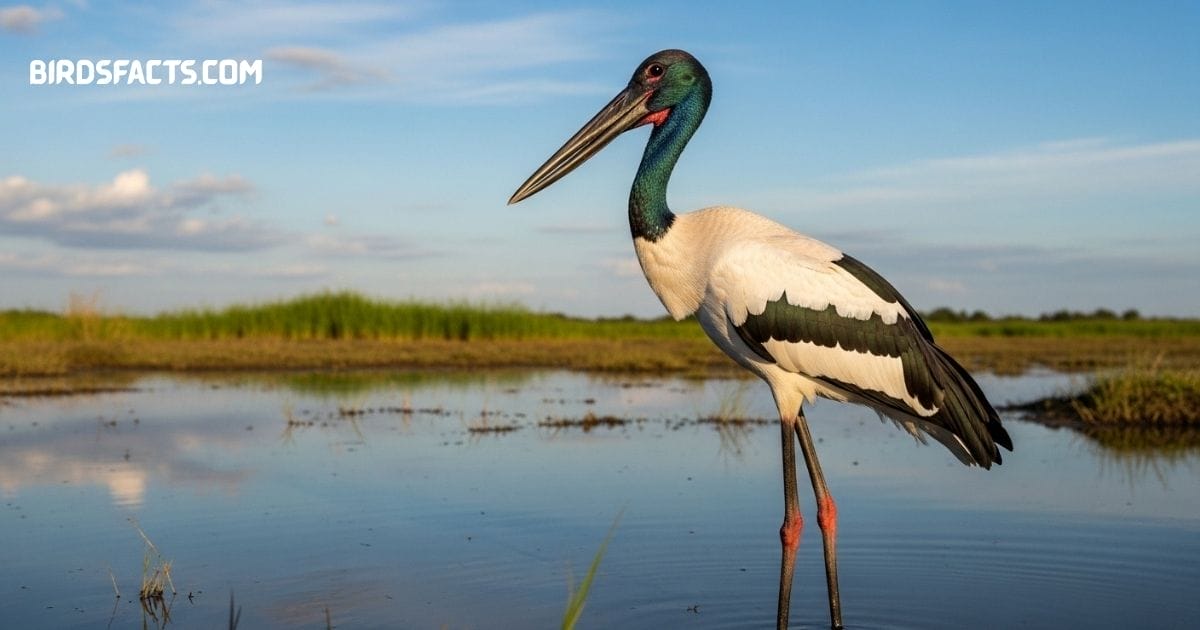
Black-necked Stork with glossy black neck and long red legs standing in shallow water
The Black Necked Stork Also Known As The Jabiru In Australia Is One Of The Tallest Birds With Long Necks Standing Over Four Feet High Its Shimmering Dark Neck Long Legs And Broad Wings Give It A Powerful And Elegant Presence In Wetlands With A Sharp Bill And Extended Reach It Skillfully Feeds On Fish Snakes And Amphibians Demonstrating Both Precision And Strength While Hunting.
Its Glossy Black Feathers Contrast Beautifully With The White Patches On Its Body Making It Instantly Recognizable In Flight Or At Rest. When Soaring Its Wings Spread Wide And Its Neck Stretches Forward Creating An Unforgettable Silhouette Across The Sky Among All Birds With Long Necks Few Can Match The Black-necked Stork’s Dramatic Beauty And Commanding Grace Making It One Of The Most Iconic Species Found In Asia And Northern Australia.
| Fact | Details |
|---|---|
| Size | Over 4 Feet Tall |
| Habitat | Wetlands Of Asia & Northern Australia |
| Diet | Fish Snakes Amphibians |
| Special Feature | Glossy Black Feathers With White Contrast |
| Fun Fact | Creates A Striking Silhouette In Flight |
Black Stork
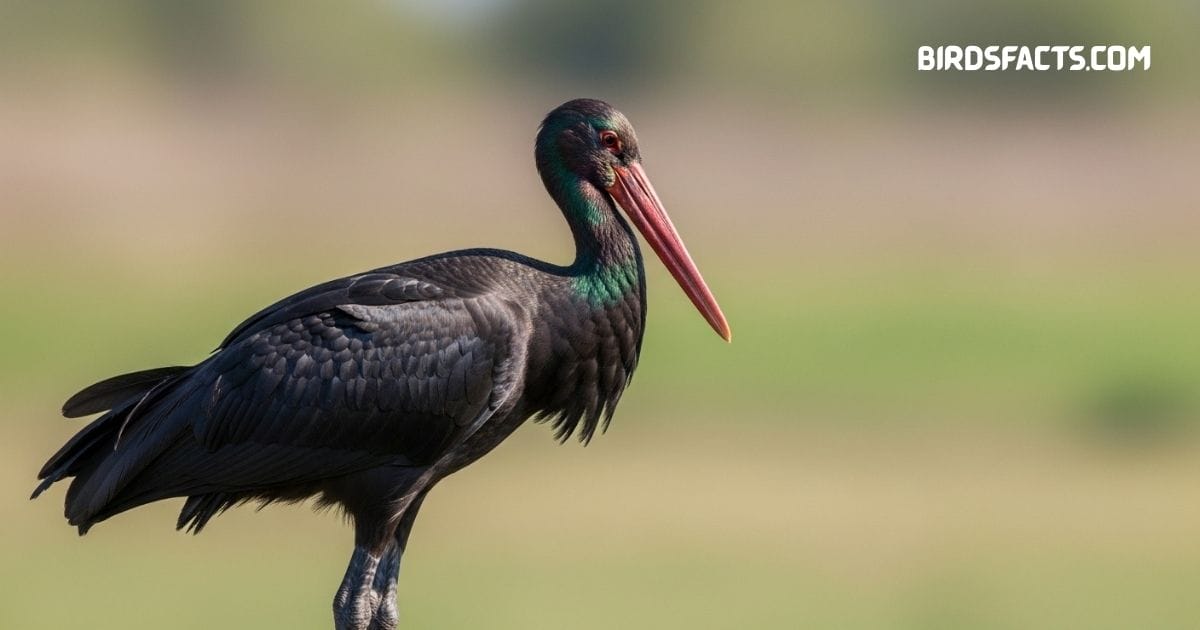
Black Stork with dark plumage and long red bill standing in shallow water
The Black Stork Is A Secretive And Less Commonly Seen Member Of Birds With Long Necks Found In Parts Of Europe Asia And Africa. Unlike The White Stork Which Often Nests Near Humans The Black Stork Prefers Secluded Wetlands And Forests. Its Long Neck Combined With A Dark Glossy Body And Red Bill Gives It A Mysterious And Elegant Appearance It Mainly Feeds On Fish Amphibians And Aquatic Insects Often Hunting Silently In Shallow Water.
During Migration Black Storks Travel Long Distances Between Europe And Africa Flying With Their Long Necks Extended In Elegant Glides. They Are Less Social Than Other Storks Often Nesting Alone Or In Small Groups Because Of Their Secretive Habits They Are Considered A Prized Sighting By Birdwatchers. As One Of The More Elusive Long-necked Birds The Black Stork Is Admired For Its Beauty Independence And Adaptability To Quiet Untouched Landscapes.
| Fact | Details |
|---|---|
| Size | Over 3 Feet Tall |
| Habitat | Wetlands Of Europe Asia Africa |
| Diet | Fish Amphibians Aquatic Insects |
| Migration | Travels Long Distances Between Europe & Africa |
| Fun Fact | Much More Secretive Than The White Stork |
Canada Goose
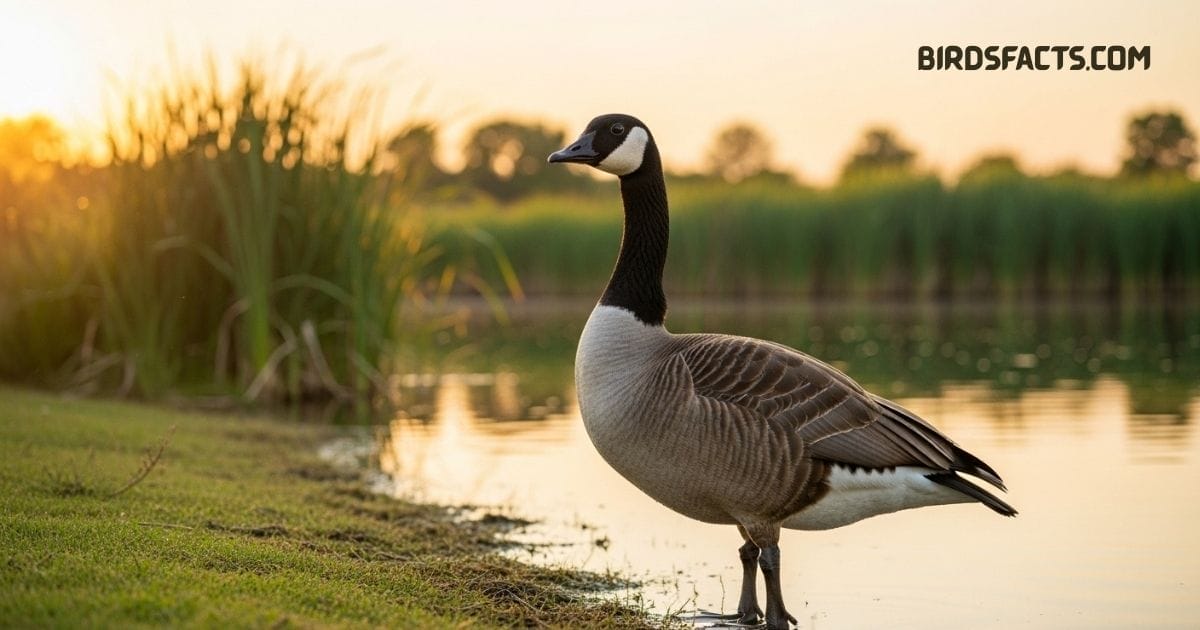
Canada Goose with black head and white cheek patch swimming on a lake
The Canada Goose Is One Of The Most Familiar Birds With Long Necks In North America. With A Black Head White Cheek Patches And Gray brown Feathers It Is Easily Identified In Parks Lakes And Grassy Fields Its Extended Neck Allows It To Graze On Grasses And Aquatic Plants Making It Well suited For Both Wild Wetlands And City Parks.
During Migration Canada Geese Are Known For Their Loud Honking Calls And V shaped Flying Formations. Their Long Necks Help Them Maintain Direction And Coordination As They Travel Great Distances Together. This Species Shows How Birds With Long Necks Can Combine Beauty Adaptability And Teamwork Thriving In Nearly Every Type Of Environment.
| Fact | Details |
|---|---|
| Size | 30–43 Inches |
| Habitat | Wetlands Parks Grassy Fields (North America) |
| Diet | Grasses & Aquatic Plants |
| Behavior | Famous V Shaped Migratory Flight |
| Fun Fact | Use Loud Honking Calls To Coordinate Migration |
Cattle Egret
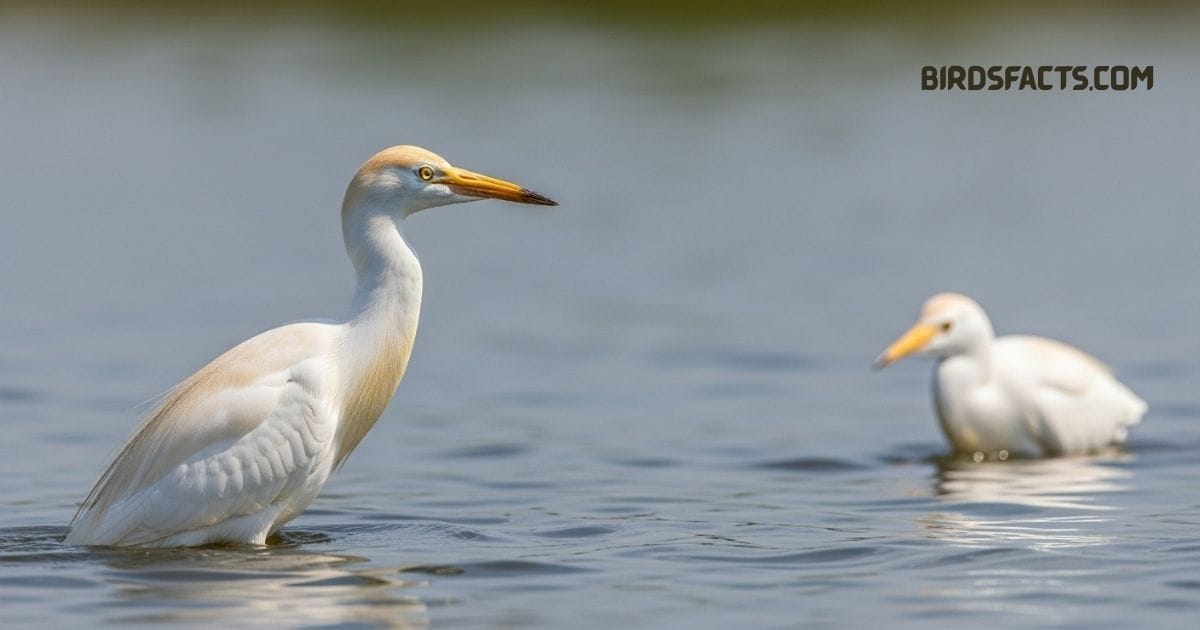
Cattle Egret with white plumage and yellow bill standing in a grassy field
The Cattle Egret May Be Smaller Than Most Birds With Long Necks But It Has A Unique Charm Of Its Own Native To Africa And Asia It Has Spread Across Nearly Every Continent Often Seen Following Cattle Or Tractors In Farmlands. Its Long Neck Helps It Scan For Grasshoppers Crickets And Other Small Creatures Disturbed By Grazing Animals. This Opportunistic Habit Makes It One Of The Most Adaptive And Widespread Species In The Egret Family.
During The Breeding Season The Cattle Egret Undergoes A Striking Transformation. Its Usually White Feathers Gain Golden orange Patches On The Head Chest And Back Adding Color To Its Appearance. With Courtship Dances And Loud Calls These Long necked Birds Bring Life To Colonies Around Wetlands And Grasslands Despite Their Smaller Size Compared To Herons Or Storks They Prove How Versatile Birds With Long Necks Can Be In Adapting To Different Ecosystems.
| Fact | Details |
|---|---|
| Size | About 20 Inches |
| Habitat | Farmlands Wetlands Grasslands (Worldwide) |
| Diet | Insects & Small Animals Disturbed By Grazing Livestock |
| Special Feature | White Body Turns Golden-Orange In Breeding Season |
| Fun Fact | Famous For Following Cattle & Farm Machinery |
Dalmatian Pelican
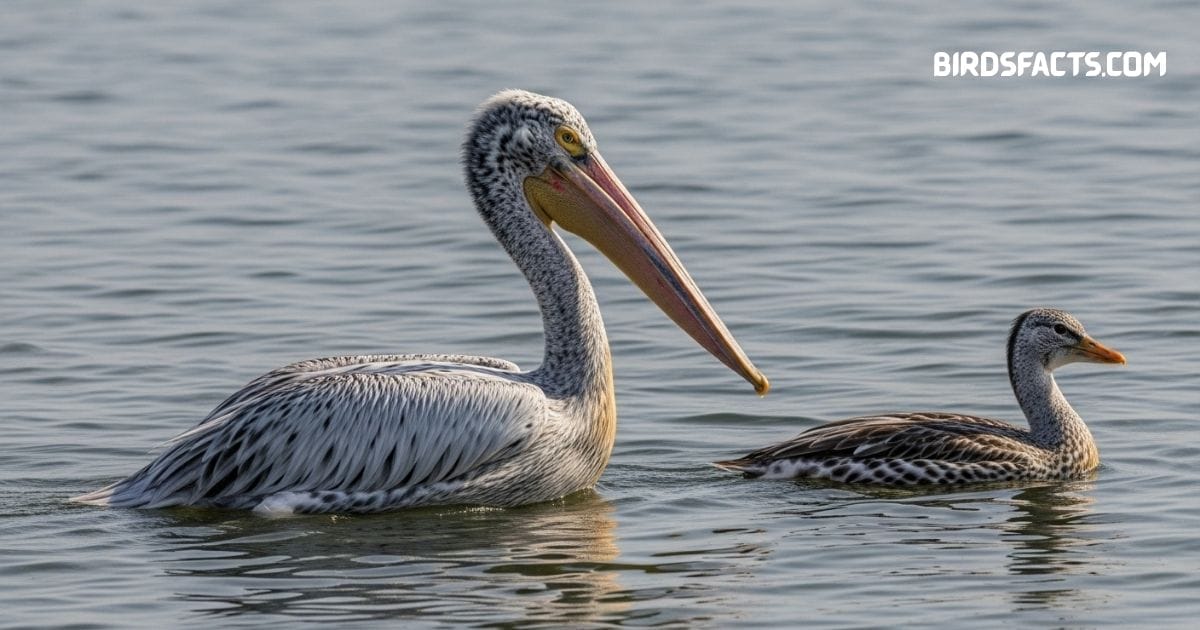
Dalmatian Pelican with massive orange bill and white plumage floating on water
The Dalmatian Pelican Is One Of The Largest Flying Birds With Long Necks Reaching Lengths Of Nearly Six Feet And Weighing Up To Thirty Pounds With An Impressive Wingspan Of Over Nine Feet It Glides Gracefully Over Lakes Rivers And Marshes Its Most Distinctive Feature Is The Enormous Bill And Gular Sac, Which Works With Its Powerful Neck To Scoop Fish In A Single Motion. Watching This Bird In Flight Feels Like Witnessing A Prehistoric Creature In Action.
In Breeding Season Its Appearance Becomes Even More Striking. Its Plumage Shifts To A Silvery White While Its Throat Pouch Turns Bright Orange Making It A Standout Among Pelicans. Groups Of Dalmatian Pelicans Often Cooperate To Herd Fish Into Shallow Waters Using Their Elongated Necks For Precision Strikes As One Of The Most Majestic Long necked Birds It Perfectly Showcases Strength Elegance And Survival In Wetland Habitats.
| Fact | Details |
|---|---|
| Size | Up To 6 Feet Long, Wingspan 9+ Feet |
| Habitat | Lakes Rivers Marshes (Europe & Asia) |
| Diet | Fish (Caught With Giant Bill & Throat Pouch) |
| Social Behavior | Cooperative Group Fishing |
| Fun Fact | Looks Almost Prehistoric When Flying |
European Spoonbill
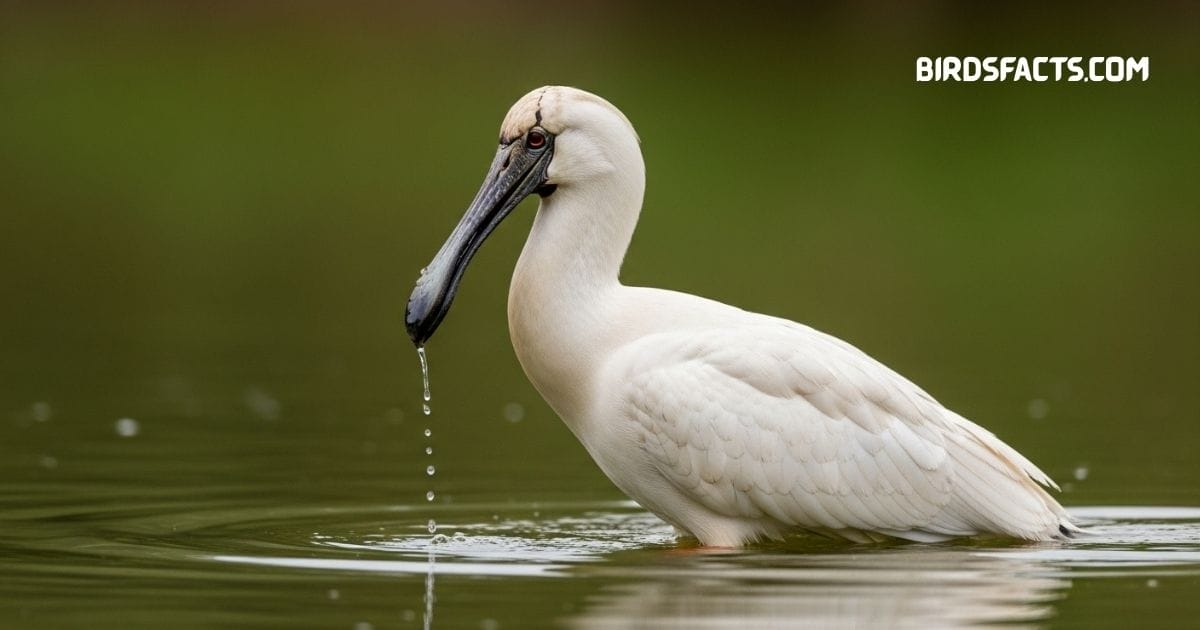
European Spoonbill with white plumage and long spoon-shaped bill wading in shallow water
The European Spoonbill Is Instantly Recognizable For Its Spoon shaped Bill Paired With A Tall Slender Body And Long Neck. Found Across Europe Africa And Asia This Bird Specializes In Feeding By Sweeping Its Head From Side To Side In Shallow Water Its Neck Allows Extended Reach Letting It Detect And Capture Small Fish Insects And Crustaceans With Ease. With Snowy White Feathers, It Creates A Striking Image Against Green Marshlands And Blue Wetlands.
These Birds Are Highly Social And Often Form Colonies Where Hundreds Feed Together Their Synchronized Movements Create The Appearance Of A Coordinated Dance In The Water, Making Them Fascinating To Watch When Flying Their Long Necks Stretch Forward In Graceful Lines Emphasizing Their Elegance. Among Birds With Long Necks Spoonbills Are Admired For Their Unusual Feeding Style And Cooperative Nature In Wetlands.
| Fact | Details |
|---|---|
| Size | About 31–36 Inches Tall |
| Habitat | Wetlands Of Europe Africa Asia |
| Diet | Fish Insects Crustaceans |
| Special Feature | Spoon-Shaped Bill |
| Fun Fact | Colonies Perform Synchronized Feeding “Dances” |
Giant Ibis

Giant Ibis with long down-curved bill and grayish-brown plumage walking in grassland
The Giant Ibis is one of the rarest and most remarkable birds with long necks known as the national bird of Cambodia Standing nearly one meter tall it has a long curved bill that it uses alongside its flexible neck to probe the ground for insects frogs and even small reptiles Its dusty gray plumage blends with its forested and marshy surroundings providing excellent camouflage from predators. Sadly habitat destruction has pushed this species close to extinction.
Fewer than a thousand individuals remain in the wild making it a prized sighting for dedicated birdwatchers. Conservation programs are working to protect its wetlands and ensure its survival Watching a Giant Ibis stretch its neck while foraging is a powerful reminder of the importance of protecting biodiversity Among endangered long necked birds this species stands as a symbol of resilience and the urgent need for conservation.
| Fact | Details |
|---|---|
| Size | About 3.3 Feet Tall |
| Habitat | Marshes & Forests (Cambodia & Southeast Asia) |
| Diet | Insects Frogs Reptiles |
| Conservation | Fewer Than 1,000 Left In Wild |
Goliath Heron
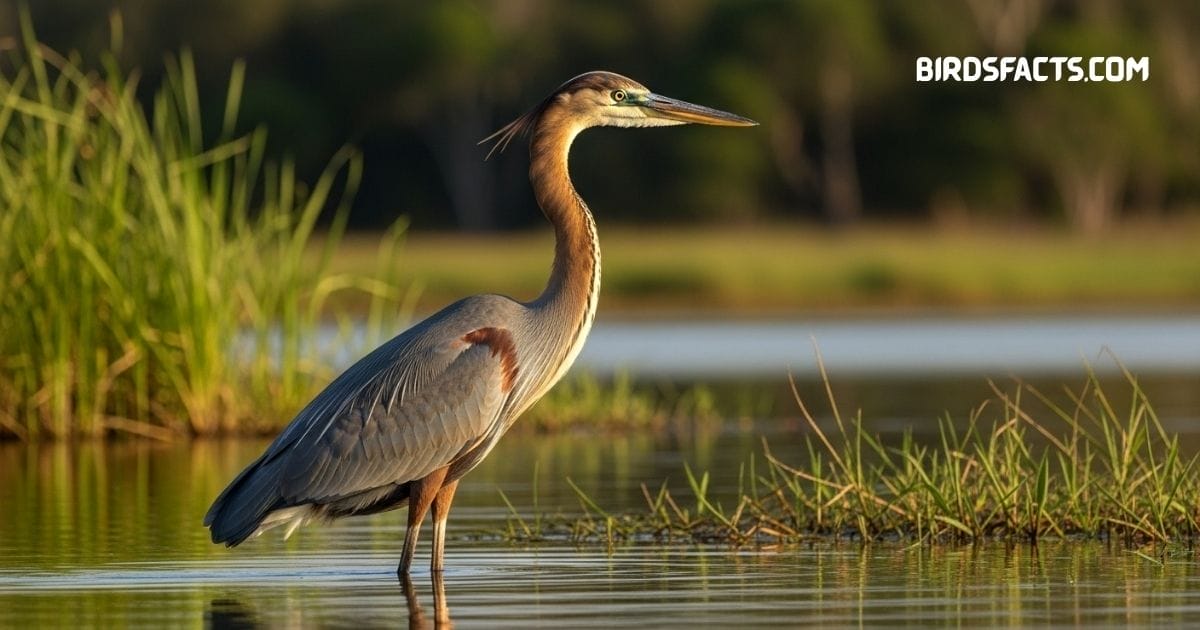
Goliath Heron with massive body and chestnut neck standing in shallow waterGoliath Heron with massive body and chestnut neck standing in shallow water
The Goliath Heron Is The Undisputed Giant Among Birds With Long Necks Often Reaching A Height Of Nearly Five Feet. Found Across Subsaharan Africa Parts Of Asia And Even The Middle East It Dominates Its Habitat Like No Other Heron Its Powerful Spear like Bill Paired With Its Extremely Long Neck Makes It Capable Of Hunting And Swallowing Fish Up To Two Feet Long. Because Of Its Size, It Rarely Needs To Compete With Smaller Herons For Food Giving It A Unique Advantage In Wetlands.
Its Reddish brown Plumage Combined With Gray And Black Tones, Gives It A Rugged Yet Majestic Appearance. The Goliath Heron Hunts Patiently Standing Completely Still In Shallow Waters Until The Right Moment To Strike With A Sudden Thrust Of Its Long Neck, It Captures Its Prey In One Quick Motion. Many Birdwatchers Describe The Experience Of Watching This Heron Hunt As Awe inspiring Almost Like Seeing A Living Dinosaur. Among Long necked Birds None Convey Such Raw Power And Grace Together.
| Fact | Details |
|---|---|
| Size | Nearly 5 Feet Tall |
| Habitat | Wetlands In Africa Asia Middle East |
| Diet | Large Fish Frogs Small Animals |
| Behavior | Patient Hunter Can Eat 2-Foot Fish |
| Fun Fact | Nicknamed “Living Dinosaur” Due To Its Size |
Great Egret

Great Egret with long white plumage and yellow bill standing in shallow water
The Goliath Heron Is The Undisputed Giant Among Birds With Long Necks Often Standing Close To Five Feet Tall And Commanding A Presence In Wetlands Across Sub Saharan Africa Parts Of Asia And The Middle East With Its Massive Spear Like Bill And Exceptionally Long Neck It Hunts And Swallows Fish Up To Two Feet Long An Impressive Feat That Few Other Birds Can Match Its Size Gives It A Clear Advantage Allowing It To Dominate Its Environment Without Needing To Compete With Smaller Herons For Food.
Its Reddish Brown Feathers Streaked With Gray And Black Give It A Rugged Yet Majestic Look. Patient And Precise The Goliath Heron Stands Motionless In Shallow Waters Waiting For The Perfect Moment To Strike. With A Lightning Fast Thrust Of Its Long Neck It Captures Its Prey In One Clean Motion Watching This Bird With A Long Neck Hunt Feels Almost Prehistoric Reminding Observers Of Nature’s Raw Power And Grace Among All Long Necked Birds None Embody Such Strength Elegance And Timeless Grandeur Quite Like The Goliath Heron.
| Fact | Details |
|---|---|
| Size | Around 3 Feet Tall |
| Habitat | Wetlands Across Four Continents |
| Diet | Fish Frogs Reptiles |
| Conservation | Once Endangered Now Recovered |
| Fun Fact | Famous For Long White Plumes In Breeding Season |
Greater Flamingo

Greater Flamingo with pale pink plumage and long legs wading in shallow water
The Greater Flamingo is the tallest member of the flamingo family and one of the most graceful birds with long necks Standing up to five feet tall with pale pink plumage and striking long legs it is found across Africa southern Europe and parts of Asia Its long neck and bent bill allow it to filter feed tiny organisms such as brine shrimp and algae from saline or alkaline lakes. These food sources give it the soft pink tones that make it so admired.
Greater Flamingos are highly social birds that live in massive colonies numbering in the thousands. During feeding they dip their long necks into the water often in synchronized movements that resemble a choreographed performance Their elaborate group displays during courtship involving head flagging and wing flapping, are breathtaking to witness. As one of the most iconic long necked birds the Greater Flamingo embodies both beauty and survival in some of the harshest wetlands on earth.
| Fact | Details |
|---|---|
| Size | Up To 5 Feet Tall |
| Habitat | Saline & Alkaline Lakes Of Africa Europe Asia |
| Diet | Brine Shrimp Algae |
| Behavior | Lives In Colonies Of Thousands |
| Fun Fact | Their Courtship Dances Look Like A Choreographed Show |
Green Heron

Green Heron with dark green back and chestnut neck perched near water
The Green Heron May Be Smaller Than Many Other Birds With Long Necks But It Is Incredibly Resourceful Found Throughout North And Central America It Usually Appears Hunched Hiding Its Long Neck Close To Its Body. However When Hunting It Suddenly Extends Its Neck With Lightning Speed To Capture Fish, Frogs, And Insects. Its Compact Size And Striking Green black Cap With Chestnut Body Make It One Of The More Colorful Heron Species.
What Truly Sets The Green Heron Apart Is Its Intelligence. It Is One Of The Few Bird Species Known To Use Tools Dropping Bait Like Insects Or Feathers Onto The Water Surface To Lure Fish Closer Once Prey Is Within Reach Its Long Neck Shoots Forward With Precision Despite Its Small Size It Demonstrates The Same Hunting Strategies That Make Long-necked Birds Successful Worldwide Birdwatchers Treasure Spotting This Clever Species Along Quiet Ponds And Marshes.
| Fact | Details |
|---|---|
| Size | About 18 Inches Long |
| Habitat | Ponds Marshes (North & Central America) |
| Diet | Fish Frogs Insects |
| Special Feature | Known For Using Bait To Fish |
| Fun Fact | One Of |
Grey Heron
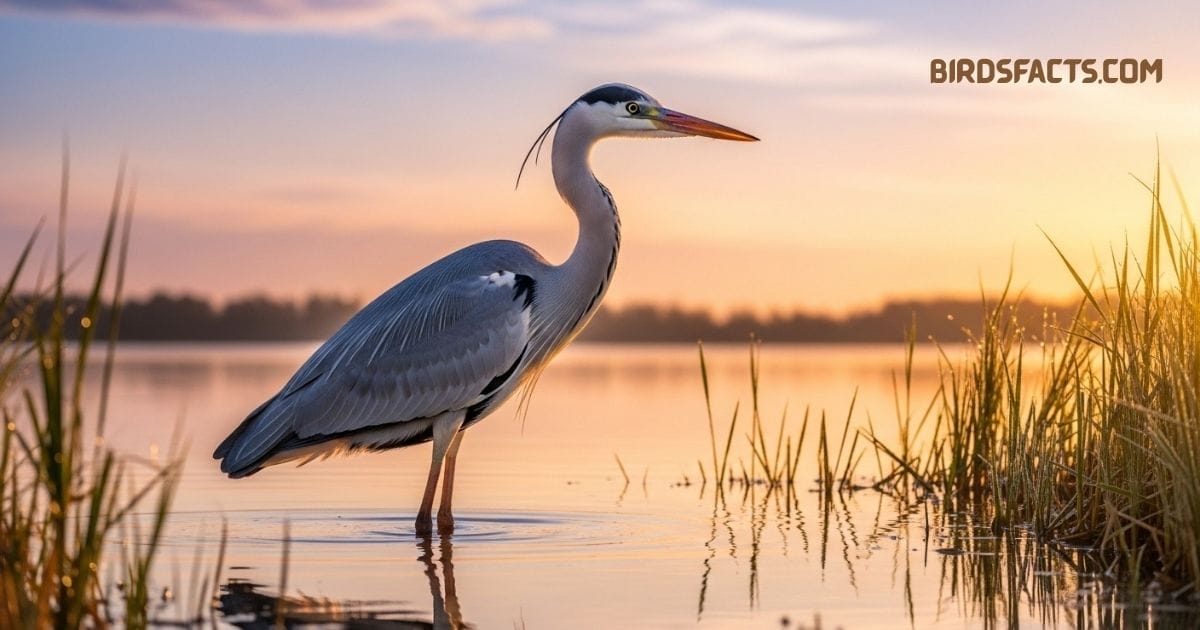
Grey Heron with long neck and gray plumage standing in shallow water
The Grey Heron Is One Of The Most Widespread Birds With Long Necks, Found Across Europe Asia And Parts Of Africa With Its Tall Stature Gray Plumage And Patient Hunting Style, It Thrives In Rivers Ponds And Wetlands Its Long Neck Allows It To Strike With Incredible Accuracy Making It A Skilled Predator Of Fish Frogs And Even Small Mammals. This Adaptability Has Made It A Common Yet Captivating Bird Across Its Range.
In Flight The Grey Heron Folds Its Neck Into An Elegant S shape Gliding Smoothly With Broad Wings Stretched Wide. It Often Nests In Colonies Known As Heronries Where Dozens Of Pairs Raise Their Young Together In Tall Trees Near Water For Birdwatchers Watching A Grey Heron Standing Motionless By A Riverbank Is A Classic Scene Of Natural Patience. Among Long necked Birds It Is Admired For Its Widespread Presence Adaptability And Quiet Strength.
| Fact | Details |
|---|---|
| Size | About 3.5 Feet Tall |
| Habitat | Rivers Ponds Wetlands (Europe, Asia, Africa) |
| Diet | Fish Frogs Small Mammals |
| Flight Style | S-Shaped Folded Neck In Flight |
| Fun Fa |
Jabiru
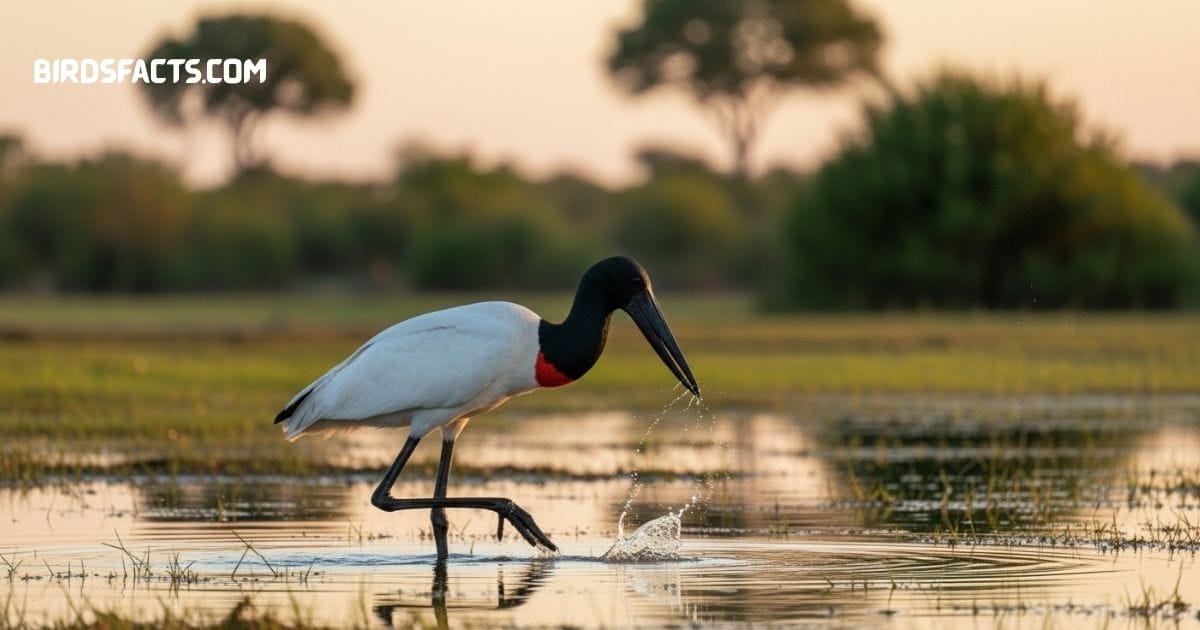
Jabiru stork with massive black bill and white plumage standing in shallow water
The Jabiru Is A Massive Stork From Central And South America, Often Considered One Of The Most Imposing Birds With Long Necks In The New World. Standing Over Four Feet Tall With A Wingspan Exceeding Eight Feet It Is Truly A Giant Of The Wetlands. Its Bare Black Head Thick Neck With A Red Patch And Strong Bill Make It Instantly Recognizable With Its Height And Long Neck, It Can Wade Deep Into Rivers And Swamps To Feed On Fish, Amphibians, And Even Small Reptiles.
What Makes The Jabiru Fascinating Is Not Only Its Size But Also Its Behavior These Birds Often Nest In Huge Trees Building Enormous Stick Nests That Can Be Reused Year After Year Their Long Neck Plays A Vital Role In Communication As They Clatter Their Bills And Perform Displays During Mating Season. Among All Long-necked Birds The Jabiru Is Celebrated As A Symbol Of Power And Resilience In The Wetlands Of South America.
| Fact | Details |
|---|---|
| Size | Over 4 Feet Tall Wingspan 8+ Feet |
| Habitat | Wetlands In Central & South America |
| Diet | Fish, Reptiles Amphibians |
| Nesting | Builds Giant Tree Nests |
| Fun Fact | Strongest Stork In The Americas |
Kori Bustard

Kori Bustard with brown mottled plumage and long legs walking in grassland
The Kori Bustard is one of the heaviest flying birds in the world and a striking member of birds with long necks Native to the open grasslands and savannas of Africa, it can weigh over 40 pounds yet still manages to take flight. Its long neck helps it scan for predators and food while walking slowly across open fields. It primarily feeds on insects small reptiles and seeds using its sharp eyesight and careful movements to survive.
During courtship male Kori Bustards put on an impressive display They puff up their necks and chest raising their feathers and emitting booming calls that can be heard across the plains. Watching this performance is like seeing a living drumbeat moving through the grasslands As one of the most iconic long necked birds of Africa the Kori Bustard shows how size, strength, and elegance can exist in a single species.
| Fact | Details |
|---|---|
| Size | Up To 40 Pounds |
| Habitat | Grasslands & Savannas Of Africa |
| Diet | Insects Reptiles Seeds |
| Courtship | Inflated Neck Displays With Booming Calls |
| Fun Fact | One Of The Heaviest Flying Birds |
Magpie Goose

Magpie Goose with black-and-white plumage and orange legs standing near water
The Magpie Goose Is A Unique Waterbird Of Northern Australia And New Guinea, Often Included Among Notable Birds With Long Necks For Its Distinctive Shape. Unlike True Geese It Represents An Ancient Lineage Making It A Living Fossil In The Bird World With Its Black-and-white Plumage And Long Neck It Thrives In Wetlands Where It Feeds On Grasses Seeds, And Aquatic Plants. It Is Especially Adapted To Seasonal Flooding, Moving In Large Flocks Across Shallow Waters.
One Of The Magpie Goose’s Most Interesting Features Is Its Social Structure. It Often Forms Lifelong Bonds And Males Are Known To Live In Trios With Two Females Raising Chicks Cooperatively. Its Long Neck Is Crucial In Feeding Allowing It To Pull Up Vegetation From Water Surfaces. For Birdwatchers Spotting Flocks Of These Long necked Birds Rising Over Wetlands Is A Reminder Of The Diversity And Ancient History Of Australia’s Birdlife.
| Fact | Details |
|---|---|
| Size | About 30 Inches |
| Habitat | Wetlands Of Australia & New Guinea |
| Diet | Grasses Seeds Aquatic Plants |
| Social Structure | Males May Bond With Two Females |
| Fun Fact | Considered A “Living Fossil” Of Bird Evolution |
Marabou Stork
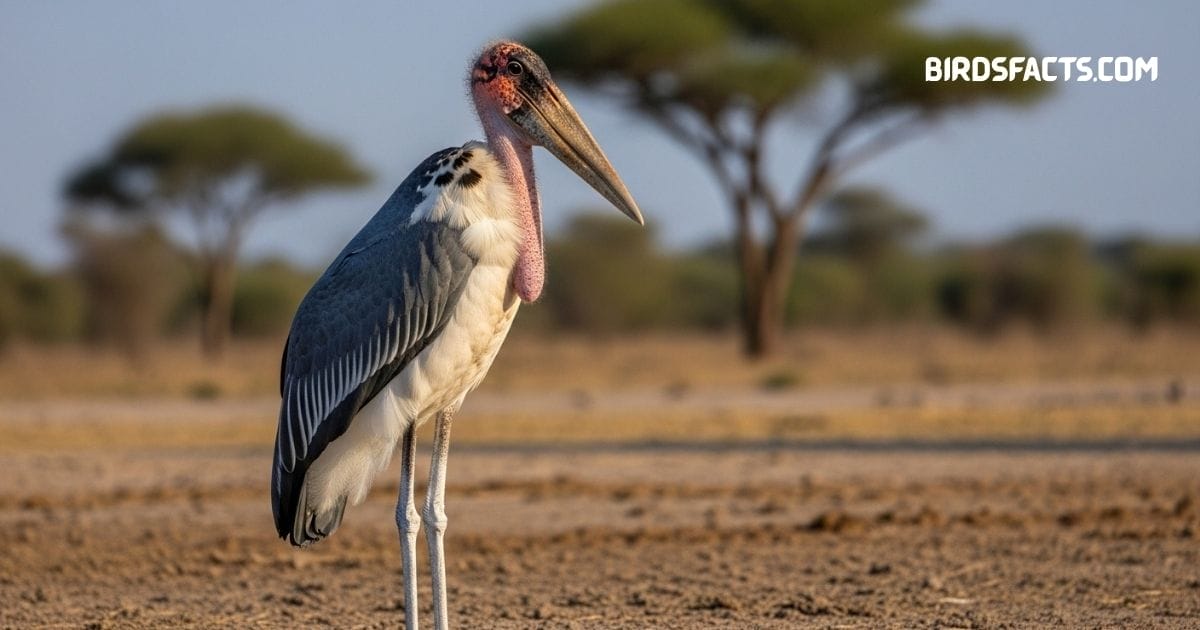
Marabou Stork with dark wings, white body, and bare pink head standing in grassland
The Marabou Stork Is One Of The Most Unusual Birds With Long Necks, Often Called The “undertaker Bird” Because Of Its Dark Feathers, Bare Head, And Hunched Posture. Native To Sub-saharan Africa, This Stork Is Enormous, Reaching Heights Of Over Five Feet With Wingspans Of Up To Ten Feet. Its Long Neck Though Somewhat Bare And Scraggly, Is Vital For Scavenging Allowing It To Reach Deeply Into Carcasses And Compete Alongside Vultures. While Many People Find It Unattractive, It Plays A Critical Role In The Ecosystem By Cleaning Up Waste And Carrion.
Despite Its Scavenging Habits, The Marabou Stork Is An Impressive Flyer. It Soars High On Warm Air Currents With Its Neck Stretched Forward And Wings Spread Wide. Colonies Of Hundreds Can Be Seen Nesting On Treetops Or Near Landfills Where Food Is Abundant For Birdwatchers It Is A Reminder That Long necked Birds Are Not Only About Beauty And Elegance But Also About Survival And Ecological Importance.
| Fact | Details |
|---|---|
| Size | 5 Feet Tall, Wingspan Up To 10 Feet |
| Habitat | Wetlands & Landfills (Africa) |
| Diet | Carrion Scraps Fish |
| Special Role | Nature’s Cleanup Crew |
| Fun Fact | Nicknamed The “Undertaker Bird” |
Mute Swan

Mute Swan with white plumage and orange bill swimming gracefully on a lake
The Mute Swan Is One Of The Most Iconic And Elegant Birds With Long Necks Admired In Parks Lakes And Rivers Across Europe Asia And North America With Its Snowy White Feathers Orange Bill And Gracefully Curved Neck It Has Become A Symbol Of Beauty And Romance In Literature And Art. Its Long Neck Is Highly Functional Allowing It To Reach Aquatic Vegetation While Gliding Gracefully On Water Watching A Mute Swan With Its Head Bowed Is Like Seeing A Painting Come Alive.
During Breeding Season These Swans Use Their Long Necks To Perform Elaborate Displays Often Mirroring Each Other’s Movements. They Are Also Fiercely Territorial, Using Their Size And Neck Strength To Defend Nests From Intruders Despite Their Serene Appearance Mute Swans Are Powerful Birds With Strong Wingbeats. Among Long-necked Birds, They Stand As A Timeless Example Of Grace Strength And Enduring Symbolism.
| Fact | Details |
|---|---|
| Size | About 5 Feet Long Wingspan 7–8 Feet |
| Habitat | Lakes & Rivers In Europe Asia North America |
| Diet | Aquatic Vegetation |
| Behavior | Graceful But Fiercely Territorial |
| Fun Fact | Neck-Curving Courtship Looks Like A Painting |
Roseate Spoonbill
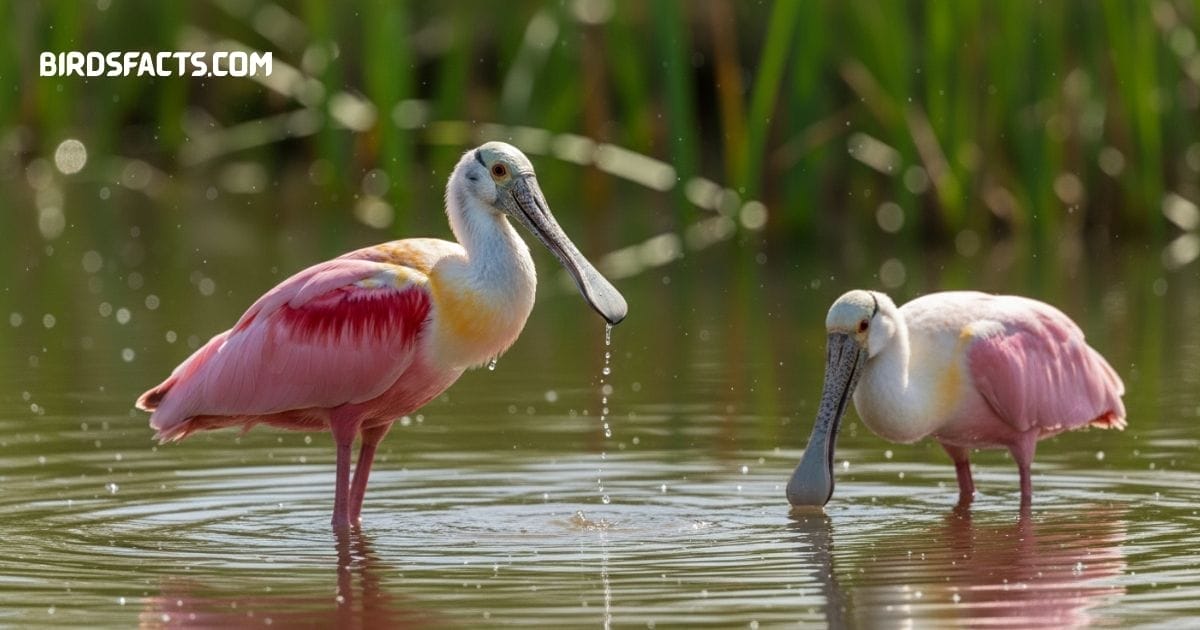
Roseate Spoonbill with pink plumage and spoon-shaped bill wading in shallow water
The Roseate Spoonbill is one of the most striking birds with long necks instantly recognized by its bubblegum pink plumage and spoon shaped bill Found across the wetlands of the Americas, from Florida to Argentina it uses its long neck to sweep its bill from side to side in shallow waters This feeding technique helps it capture small fish, crustaceans and insects. The rosy color comes from the pigments in the crustaceans it eats much like flamingos.
In flight the Roseate Spoonbill stretches its neck forward showing off its vibrant feathers against the sky During the breeding season its colors become even more intense making it one of the most photogenic species in wetland bird colonies. Birdwatchers are always thrilled to spot this unusual bird as its appearance feels like something out of a tropical painting It proves that birds with long necks are not only adaptive but also some of the most beautiful creatures in the avian world.
| Fact | Details |
|---|---|
| Size | About 28–34 Inches Tall |
| Habitat | Wetlands In The Americas |
| Diet | Fish Insects Crustaceans |
| Special Feature | Spoon Shaped Bill & Pink Plumage |
| Fun Fact | Bright Pink Color Comes From Crustacean Diet |
Rüppell’s Griffon Vulture

Rüppell’s Griffon Vulture with brown wings and pale head perched on a rock
Rüppell’s Griffon Vulture is one of the most remarkable birds with long necks known for soaring higher than almost any other bird in the world Native to the Sahel region of central Africa this vulture can fly at altitudes of over 35,000 feet higher than Mount Everest. Its long neck and bald head are perfectly adapted for scavenging allowing it to reach deep inside carcasses without fouling its feathers. These birds are nature’s cleanup crew, preventing disease by consuming remains that would otherwise rot in the wild.
Despite their somewhat grim lifestyle, Rüppell’s Vultures are magnificent in flight With wingspans of nearly nine feet and long necks extended, they glide effortlessly on thermals, covering vast distances in search of food. They are highly social often feeding and nesting in large colonies on cliffs. Among long necked birds Rüppell’s Griffon Vulture represents both resilience and essential ecological balance proving that beauty also lies in functionality and survival.
| Fact | Details |
|---|---|
| Size | 33–41 Inches, Wingspan 8–9 Feet |
| Habitat | African Savannas Cliffs |
| Diet | Carrion |
| Flight | Can Soar Above Mount Everest’s Height |
| Fun Fact | Highest Flying Bird In The World |
Sandhill Crane

Sandhill Crane with gray body and red crown standing in a marsh
The Sandhill Crane Is One Of The Most Graceful And Elegant Birds With Long Necks Commonly Seen Across The Wetlands Grasslands And Farmlands Of North America With Their Soft Gray Feathers Red Crown Patches And Tall Slender Legs These Cranes Are Unmistakable Even From A Distance. Their Long Necks Help Them Forage Efficiently Probing The Soil For Grains Seeds And Small Invertebrates Each Year Thousands Of Sandhill Cranes Migrate In Breathtaking Formations Their Resonant Trumpet Like Calls Echoing Across The Skies.
One Of The Most Captivating Sights In Nature Is The Sandhill Crane’s Courtship Dance Both Males And Females Leap High Into The Air Bow Gracefully And Flap Their Wings While Arching Their Necks In Perfect Rhythm. These Dances Serve Not Only As Mating Displays But Also As A Way To Strengthen Social Bonds Within Pairs And Flocks Among All Long Necked Birds The Sandhill Crane Stands As A Timeless Symbol Of Grace Unity And The Enduring Beauty Of The Wild.
| Fact | Details |
|---|---|
| Size | 3.5–4.5 Feet Tall |
| Habitat | Wetlands & Grasslands (North America) |
| Diet | Seeds Grains Insects Small Animals |
| Special Feature | Trumpeting Calls & Dances |
| Fun Fact | Courtship Dances Also Strengthen Social Bonds |
Sarus Crane
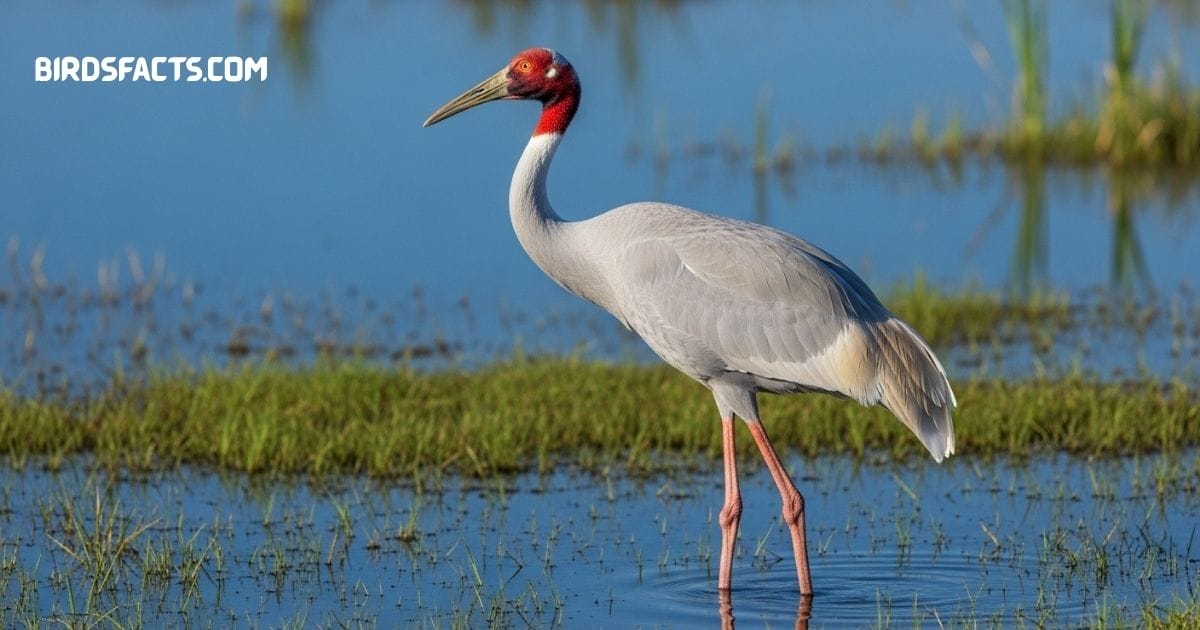
Sarus Crane with gray body and red head standing in wetland grass
The Sarus Crane Is The Tallest Flying Bird In The World And An Extraordinary Member Of Birds With Long Necks Standing Nearly Six Feet Tall, It Is Found Across The Wetlands Of India, Southeast Asia, And Northern Australia. Its Striking Gray Body, Bright Red Head And Elongated Neck Make It A Majestic Sight In Open Landscapes Unlike Many Cranes Sarus Cranes Are Non migratory And Remain Near Their Breeding Grounds Year round.
What Makes Them Remarkable Is Their Lifelong Monogamous Pair Bonds. During Courtship, Sarus Cranes Stretch Their Necks Skyward And Emit Loud Trumpeting Calls That Can Be Heard For Miles. Their Synchronized Dances Are Both Elaborate And Beautiful Symbolizing Fidelity And Partnership Observing Sarus Cranes In The Wild Is Like Watching Living Statues In Motion. As One Of The Most Iconic Long-necked Birds, They Embody Strength, Devotion, And The Beauty Of Wetland Ecosystems.
| Fact | Details |
|---|---|
| Size | Up To 6 Feet Tall |
| Habitat | Wetlands Of India SE Asia Australia |
| Diet | Aquatic Plants Insects Small Animals |
| Behavior | Monogamous Lifelong Bonds |
| Fun Fact | World’s Tallest Flying Bird |
Scarlet Ibis

Scarlet Ibis with bright red plumage and long curved bill wading in shallow water
The Scarlet Ibis Is One Of The Most Vibrant Birds With Long Necks, Instantly Recognized By Its Flaming Red Plumage Native To South America And The Caribbean It Thrives In Coastal Mangroves, Mudflats, And Estuaries. Its Long Curved Bill And Extended Neck Allow It To Probe The Mud For Crabs Insects And Small Shellfish The Brilliant Scarlet Color Comes From Carotenoid Pigments In Their Diet Similar To Flamingos.
In Flight Scarlet Ibises Form Dazzling Flocks That Light Up The Sky With Red Streaks Their Long Necks Stretch Forward As They Glide Often In Synchronized Formations. Colonies Can Number In The Thousands Creating One Of The Most Spectacular Sights In The Natural World. For Bird Enthusiasts The Scarlet Ibis Is Not Only A Symbol Of Tropical Beauty But Also A Reminder That Long necked Birds Can Be Both Practical Hunters And Breathtaking Visual Wonders.
| Fact | Details |
|---|---|
| Size | 22–25 Inches Tall |
| Habitat | Mangroves Mudflats (South America & Caribbean) |
| Diet | Crabs Insects Small Shellfish |
| Coloration | Red Color From Crustaceans In Diet |
| Fun Fact | Colonies Can Number In The Thousands |
Tricolored Heron
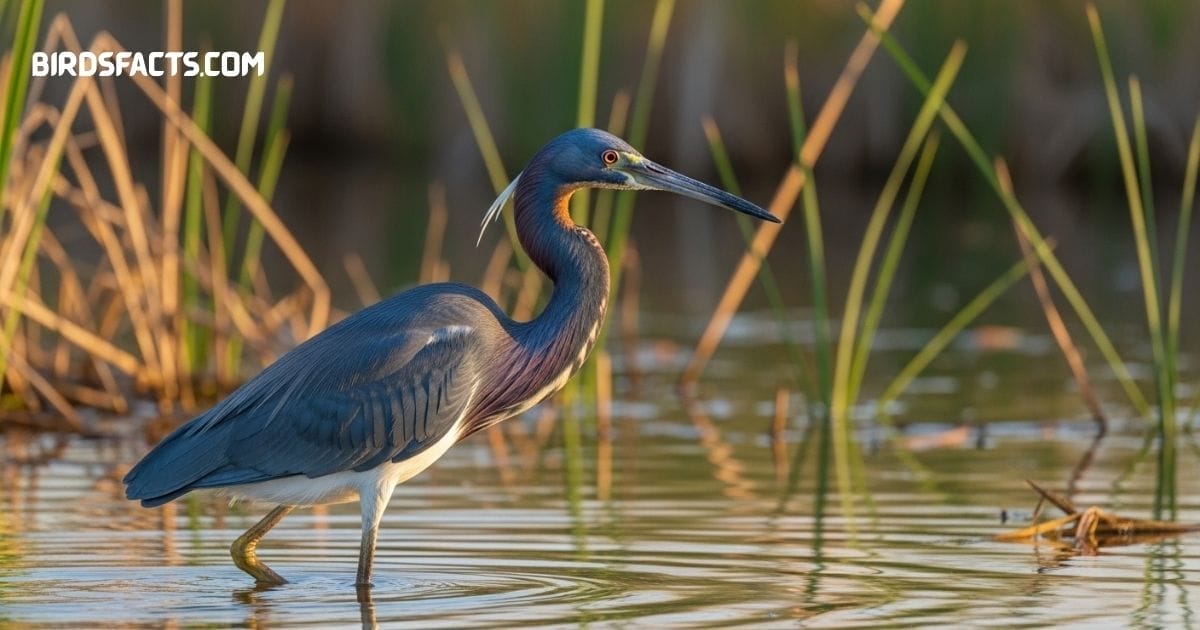
Tricolored Heron with blue-gray body, white belly, and slender neck wading in water
The Tricolored Heron Is One Of The Most Striking Birds With Long Necks Easily Recognized By Its Blue gray Body White Belly And Reddish Neck Found Mainly In The Coastal Wetlands Of The Southeastern United States Central America And South America This Heron Thrives In Shallow Waters. Its Long Neck Allows It To Strike At Fish And Crustaceans With Incredible Accuracy Unlike Larger Herons That Stand Still The Tricolored Heron Often Stalks Its Prey With Quick Darting Movements Giving It An Energetic Personality.
During The Breeding Season Its Neck And Body Colors Become More Vibrant With Beautiful Plumes Adding To Its Charm Birdwatchers Often Marvel At Its Aerial Displays And Courtship Dances Where Its Neck Is Used For Posturing And Signaling Among Long-necked Birds, The Tricolored Heron Stands Out For Its Graceful Movements Vivid Coloration And Lively Feeding Style, Making It A Favorite Sight In Marshes And Estuaries.
| Fact | Details |
|---|---|
| Size | About 24 Inches Tall |
| Habitat | Coastal Wetlands (Americas) |
| Diet | Fish & Crustaceans |
| Hunting Style | Active Stalker With Quick Movements |
| Fun Fact | Colors Become More Vibrant In Breeding Season |
White-faced Ibis

White-faced Ibis with iridescent bronze-green plumage and long curved bill wading in shallow water
The White faced Ibis Is Another Fascinating Member Of Birds With Long Necks Known For Its Long Down curved Bill And Shimmering Plumage. Found In Wetlands Across North And South America It Forages In Shallow Water And Mudflats Using Its Long Neck To Probe For Insects Crustaceans And Small Invertebrates Its Feathers Shine With Iridescent Hues Of Bronze Green And Purple Making It Especially Attractive When Seen Under Sunlight.
During The Breeding Season The White Faced Ibis Develops A Striking White Border Around Its Face And Bright Red Legs Giving It A Distinctive And Graceful Appearance These Birds Are Highly Social Often Feeding In Large Flocks And Moving Their Long Necks In Rhythmic Harmony While Foraging In Shallow Wetlands. Their Synchronized Movements Are Mesmerizing To Watch Reflecting Unity And Balance In Nature Among Birds With Long Necks The White Faced Ibis Stands Out As A Symbol Of Beauty Cooperation And Adaptability Within Marsh Ecosystems.
| Fact | Details |
|---|---|
| Size | 18–22 Inches Tall |
| Habitat | Wetlands (North & South America) |
| Diet | Insects Crustaceans Small Invertebrates |
| Breeding Feature | White Facial Border & Red Legs |
| Fun Fact | Feeds In Synchronized Flocks |
Whooping Crane

Whooping Crane with white body and red crown standing in marshland
The Whooping Crane Is One Of The Rarest And Most Endangered Birds With Long Necks, But Also One Of The Most Majestic Standing Nearly Five Feet Tall It Has Pure White Plumage Black Wingtips And A Striking Red Crown. Native To North America It Was Once Nearly Extinct With Only A Few Dozen Individuals Left In The Wild Thanks To Conservation Programs, Its Population Has Slowly Increased Though It Is Still Considered Endangered.
Its Long Neck Is Essential For Both Feeding And Communication. Whooping Cranes Use Their Necks During Elaborate Courtship Dances Which Include Leaping, Bowing, And Wing Flapping. Their Loud Trumpet-like Calls Echo Across Wetlands And Are Often Produced With Their Necks Stretched High For Bird Lovers, Spotting A Whooping Crane Is A Once-in-a-lifetime Experience. Among Long-necked Birds It Represents Both Fragility And Hope For Conservation Success.
| Fact | Details |
|---|---|
| Size | Nearly 5 Feet Tall |
| Habitat | Wetlands (North America) |
| Diet | Crustaceans Fish Plants |
| Conservation | Critically Endangered But Recovering |
| Fun Fact | Loud Calls Echo For Miles Across Wetlands |
Yellow-billed Stork
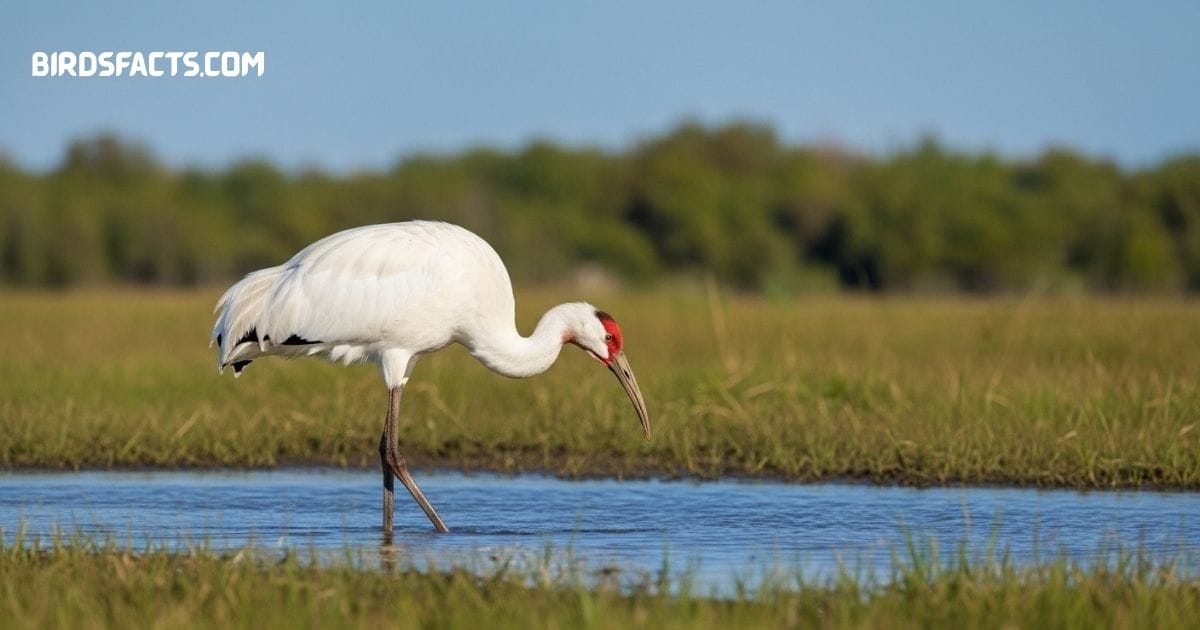
Yellow-billed Stork with white plumage and long yellow bill wading in shallow water
The Yellow billed Stork Is One Of The Most Recognizable African Birds With Long Necks Named For Its Bright Yellow Bill And Striking White Body With Black Wing Edges. It Inhabits Rivers Lakes And Wetlands Across Sub saharan Africa Where It Uses Its Long Neck And Bill To Sweep Through Shallow Water In Search Of Fish Frogs And Insects. Its Feeding Style Is Both Effective And Graceful Making It A Favorite Subject For Wildlife Photographers.
During Courtship Yellow billed Storks Display Their Long Necks Proudly Engaging In Wing-flapping And Bill-clattering Rituals Colonies Of These Birds Often Nest In Large Trees, Creating A Noisy And Lively Spectacle When In Flight Their Long Necks Extend Forward And Their Wide Wings Give Them A Commanding Presence In The Sky. Among Long necked Birds, The Yellow billed Stork Is Admired For Its Striking Beauty Social Nature And Vital Role In Wetland Ecosystems.
| Fact | Details |
|---|---|
| Size | About 3 Feet Tall |
| Habitat | Rivers Lakes Wetlands (Africa) |
| Diet | Fish Frogs Insects |
| Feeding Style | Sweeping Bill Through Water |
| Fun Fact | Highly Social Nesting In Noisy Colonies |
FAQs
What Is A Bird With A Long Neck Called?
It’s Commonly Referred To As A Long-necked Bird Like A Heron Stork Or Flamingo.
Why Do Birds Have Long Necks?
They Use Long Necks For Feeding Spotting Predators And Showing Off During Courtship.
Which Is The Largest Bird With A Long Neck?
The Goliath Heron Is The Largest Among All Birds With Long Necks Reaching Nearly 5 Feet Tall.
Why Do Flamingos Have Such Long Necks?
Flamingos Need Long Necks To Filter feed In Shallow Waters While Keeping Their Balance.
What Do Long-necked Birds Usually Eat?
They Eat Fish Insects Amphibians Plants And Sometimes Small Reptiles
conclusion
From Wetlands And Grasslands To Forests And Coastal Lagoons The World Of Birds With Long Necks Is As Diverse As It Is Breathtaking Each Species We Explored From The Towering Goliath Heron To The Vibrant Scarlet Ibis Shows How Evolution Has Shaped Their Long Necks For Survival. Whether It’s For Striking Prey, Filtering Food Displaying Courtship Rituals Or Scanning For Predators Their Elongated Necks Are More Than Just Beauty; They Are Essential Tools Of Adaptation Watching Them In Their Natural Habitat Reminds Us Of How Extraordinary Nature Can Be When Form And Function Come Together In Harmony.
For Birdwatchers And Nature Lovers Alike, Spotting These Species Is Always A Special Moment. Some Like The American Flamingo, Dazzle With Color While Others, Like The Whooping Crane Or Giant Ibis Inspire Hope For Conservation. Collectively, These Long necked Birds Highlight The Importance Of Protecting Wetlands Rivers Grasslands And Forests That Sustain Them By Preserving Their Habitats We Not Only Ensure The Survival Of These Elegant Creatures But Also Protect Entire Ecosystems That Depend On Them. Truly Birds With Long Necks Are Among Nature’s Greatest Wonders And They Deserve Our Admiration And Care For Generations To Come.








